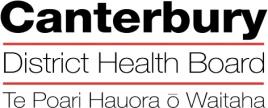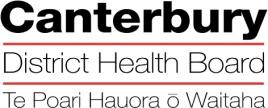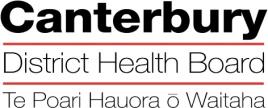
 Canterbury District Health Board
Canterbury District Health Board
Private Bag 4711
Christchurch
21 April 2022
Dr Sue Calvert
Midwifery Council
Via email:
[email address]
[email address]
Please accept this feedback on behalf of Canterbury and West Coast District Health Boards.
Thank you for sharing the work of the Reference group who were charged with reviewing the Scope of
Practice. We fully support the Council on the inclusion and application of Te Tiriti o Waitangi within
the revised Scope of Practice and the desire to pursue more equitable and culturally responsive
midwifery care for people who are hapū.
Our comments are based around the aspirations of the Council and the Reference Group for a broader
and more comprehensive scope that reflects Te Tiriti o Waitangi. The impact of the revisions within
the scope also must consider not only the aspirations of the profession about the future of the role of
a midwife but also acknowledge the realities of our current workforce and the exceptional pressure
we experience in providing safe maternity services to our communities. This pressure is felt across the
profession wherever they work.
Our feedback draws attention to some concerns we have about the proposed changes and potential
unintended consequences that we would ask to be considered by Council. We then make some
suggested wording changes that may satisfy these concerns.
1. Our interpretation of one of the changes is that the scope of a midwife would be expanded to
include all sexual health, all infant health, and all whānau health. This significantly expands the
role of the midwife and may lose midwives to their core role and instead see midwives working
exclusively in these new fields. This will lead to the dispersion of the workforce over a larger
scope with fewer qualified midwives being available for pregnancy; labour and immediate
postnatal care, which has been the unique domain of a midwife. We are concerned that this
may have an unintended consequence which could result in an increased risk to public safety
with many more hapū people unable to access midwifery care. From a regulator perspective
we would ask that this is reconsidered and suggest that the opening clause change to:
Te Tiriti o Waitangi is embedded in the practice of a kahu pōkai / midwife in Aotearoa New
Zealand. The kahu pōkai / midwife provides culturally and clinically safe care, for wāhine /
women / people / whānau+
at all stages of pregnancy and early postpartum up to 6 weeks, to
facilitate births, and provide care for the newborn.
2. Expanding the scope to include all sexual health, all infant health, and all whānau health
significantly expands the role of the midwife resulting in a much larger knowledge and skills
base required particularly in rural Aotearoa. Our question of Council is how this will be
achieved both for those midwives who are currently being regulated by the Council and those
students of midwifery and the expectations of their undergraduate programme. Clarity
regarding how the CLG considered this would be rolled out may help dispel the concerns we

 Canterbury District Health Board
Canterbury District Health Board
Private Bag 4711
Christchurch
have because we can see benefits to this but not how it is currently presented. The impact of
this change is either to expand the undergraduate programme to cover the new knowledge
and skills resulting in a significantly longer undergraduate programme, or to accepting that
midwives will be able to work in the above areas with post registration education offering
these additions to their base scope much as is being done regarding the addition of abortion
to our scope. It is possible to add sexual health, infant health, and whānau health as an
extended scope with an accompanying credentialing for those that wish to do this as occurs
with other workforces. We also discussed the role midwives have as navigators and facilitators
for whānau as well as the hapū person. This is a role midwives have always had and it would
be good if clarity and recognition of this is reflected in scope.
3. Expanding the scope without time parameters for the midwifery role i.e. from preconception
to six weeks postpartum, leaves employed midwives highly vulnerable to redeployment into
non-maternity wards to fill nursing shortages. Currently the time parameters and clarity about
what we are and are not regulated to provide and to whom means that for our employed
midwives within the profession this redeployment does not occur. If the scope changes as this
is currently written without such parameters it will result in employed midwife
disenfranchisement and increased attrition, increasing risk to public safety particularly within
the maternity services in secondary/ tertiary hospitals. Unfortunately, these services are being
utilised more than in the past as the health of our population generally worsens often due to
the obesity challenges leading to other co-morbidities.
4. There is lack of clarity around what care can be provided on the midwife’s sole responsibility
and what can be provided as part of a wider health care team. This potentially creates
problems when practitioners step outside the intention of the scope and deliver care which
they are not qualified to provide for example prescribing anti-hypertensives or treating asthma
or treating infants. Similarly, in the reverse, what has always been considered the autonomy
of midwifery practice and our responsibility, could now instead give the impression that care
is only delivered under the supervision and delegation of a doctor. This is of significant concern
to all midwives who currently carry considerable professional responsibility alongside their
medical colleagues with guidance that has enable strong interfaces and collegial discussions in
most circumstances when that care moves into a more complex clinical situation.
5. The current scope also states that a midwife “
identifies complications that may arise in mother
and baby, accesses appropriate medical assistance, and implements emergency measures as
necessary”. This clearly identifies the boundaries of autonomous practice as within the realm
of normal and collaborative practice when required, as well as enabling midwives to manage
emergencies when they may be the only practitioner available.
6. Whilst the revised Scope is suggestive of autonomous practice in the clause which includes
“
assess, plan, diagnose, provide, and evaluate care, including prescribing medicines”, it is not
explicit, such as in the current Scope which states that the midwife works…. “
on their own
professional responsibility to give women the necessary support, care and advice during
pregnancy, labour and the postpartum period up to six weeks, to facilitate births and to provide
care for the newborn”. “In all settings, the midwife remains responsible and accountable for
the care they provide.” Although it may be considered that this is so embedded in practice that
it need not be specifically articulated, history demonstrates the necessity of protecting what
is unique and valuable about our profession and should be something the regulator also
explicitly states.


 Canterbury District Health Board
Canterbury District Health Board
Private Bag 4711
Christchurch
7. There is reference within the revised Scope that midwives will be able to provide care for
infants. The definition of an infant is considered within many health and educational settings
as one year of age, although references can be found to include children up to two years of
age. This means that care provision which includes infant health is potentially open to different
interpretations.
8. There has also been discussion about this scope and whether midwives still have to declare
they work across the scope or is this changing to work within the scope. What will midwives
have to do to get an APC each year?
9. Finally, a question has been raised about when a member of the public picks up this scope, is
it clear what the role of a midwife is? What does a midwife do and what is she accountable
for? Due to the vague nature of aspects of it we are concerned about indemnity increases due
to changed expectations.
Yours sincerely
Ngā mihi
Norma Campbell
Executive Director of Midwifery and Maternity Services
Canterbury District Health Board and West Coast District Health Board
[email address]






